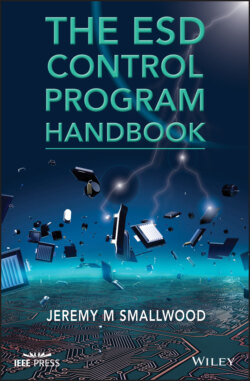Читать книгу The ESD Control Program Handbook - Jeremy M. Smallwood - Страница 72
2.7 Electronic Models of ESD
ОглавлениеMany ESD sources can be simply modeled using a simple R‐L‐C circuit (Figure 2.21). The values of each component vary widely between different sources and help to explain the different types of waveforms observed.
At the heart of any ESD source is charge build‐up and storage. This is represented by the capacitance in the model C. In many cases in real life, this charge storage may be on a conductor (e.g. metal item).
Figure 2.20 ESD waveform from a charged automotive wiring loom cable lying against an earthed metal plate. Positive (above) and negative (below) charging polarity.
Figure 2.21 Electronic model of a simple ESD source.
The discharge is usually initiated by a breakdown of an air gap or some other insulating medium. At low voltages, it can also be initiated by contact or near‐contact between two conductors. The discharge can itself have significant impedance RESD that can affect the waveforms produced and the energy delivered into the victim device. Often, however, this is negligible compared to the other impedances in the circuit, especially for larger ESD events.
After the discharge commences, the current flows through some circuit that includes some elements of resistance Rs and inductance Ls. These are normally due to the resistance and electrical properties of the materials in the current path.
In the case of ESD to a victim device, the device also has impedance, modeled in this simple circuit by a resistance Rd. In practice, a nonlinear impedance would be more typical of a semiconductor device. The impedance of the spark channel is highly variable and nonlinear.
For simplification, the total circuit resistance R is assumed to be linear and is the sum of the circuit resistances.
The discharge current IESD of this circuit has the form
For derivation of the equations for this and the following equations, the reader is referred to other texts (e.g. Agarwal and Lang 1987, https://en.wikipedia.org/wiki/RLC_circuit). This equation has two roots α, β given by
The waveform shape takes very different forms depending on the circuit component values. If the total circuit resistance is large and dominates the discharge path impedance, the waveform has a unidirectional shape, simulated in Figure 2.22 using model component values given for human‐body model ESD (see Table 3.12). This occurs when
Figure 2.22 Simulated overdamped device current waveform IESD for dominant circuit resistance: Rs = 1500 Ω, Rd = 10 Ω, RESD = 0 Ω, Ls = 10 000 nH, Cs = 100 pF, VESD = 500 V.
The discharge current rises rapidly to a peak Ip that, when inductance is small, approaches the value and polarity near that predicted by Ohms law.
Thereafter, the current drops nearly exponentially with decay time approaching RsCESD.
At the other extreme, if the circuit resistance is insignificant compared to the inductive and capacitive impedance, the waveform is quite different. This occurs when
The waveform rises to a peak and then oscillates negative and positive about zero. The overall amplitude decays exponentially with time, simulated in Figure 2.23 using values given for machine model ESD (Table 3.12).
Between the two extremes, the waveform duration decreases and is minimum around the point of critical damped waveform, where the waveform changes between the two different shape types. This is simulated in Figure 2.24 using model values close to those given for the charged device model (Table 3.12). This occurs at the condition
Practical ESD sources often require the addition of more components (e.g. additional capacitors) to better represent additional charge storage (e.g. metal parts) and other features that may be present. These may contribute further current peaks or modify the shape of the waveform (Verhage et al. 1993).
The stored energy EESD in a conductive ESD source is given by
Figure 2.23 Simulated underdamped device ESD current waveform for the case of low circuit resistance (dominant inductive and capacitive impedance): RESD = 10 Ω, Rd = 10 Ω, Ls = 750 nH, Cs = 200 pF, VESD = 500 V.
Figure 2.24 Simulated device ESD current waveform for near critical damping: RESD = 20 Ω, Rd = 10 Ω, Ls = 2.5 nH, Cs = 10 pF, VESD = 500 V.
All this energy is dissipated in the total circuit resistance R. Only a fraction of this is the energy dissipated in the device Ed.
In a source such as the charged human body that has significant resistance, most of the stored energy is dissipated in the circuit (body) resistance, and only a small fraction is dissipated in the victim device. In contrast, a charged metal object is a low‐resistance ESD source, and most of the stored energy can be dissipated in the victim device. This is one reason why some components may be damaged by a lower voltage with a metal ESD source compared to a charged person. In general, the likelihood of ESD damage to a component by ESD from a source will depend on the susceptibility of the device to ESD current, voltage, energy, or other parameter of the discharge. This is further discussed in Chapter 3.
